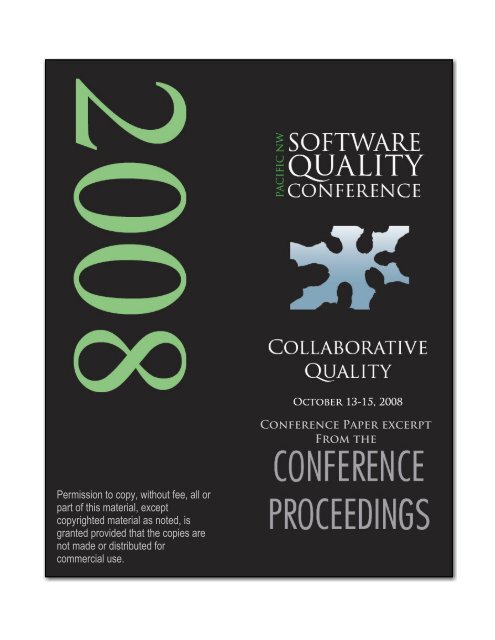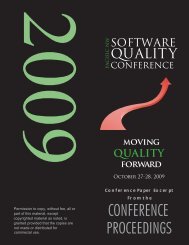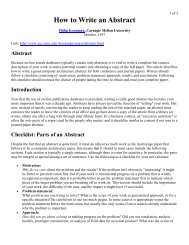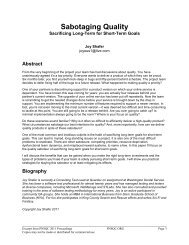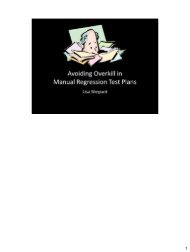Permission to copy, without fee, all or part of this material ... - PNSQC
Permission to copy, without fee, all or part of this material ... - PNSQC
Permission to copy, without fee, all or part of this material ... - PNSQC
Create successful ePaper yourself
Turn your PDF publications into a flip-book with our unique Google optimized e-Paper software.
<strong>Permission</strong> <strong>to</strong> <strong>copy</strong>, <strong>without</strong> <strong>fee</strong>, <strong>all</strong> <strong>or</strong><br />
<strong>part</strong> <strong>of</strong> <strong>this</strong> <strong>material</strong>, except<br />
<strong>copy</strong>righted <strong>material</strong> as noted, is<br />
granted provided that the copies are<br />
not made <strong>or</strong> distributed f<strong>or</strong><br />
commercial use.<br />
Conference Paper excerpt<br />
From the
Collab<strong>or</strong>ative Techniques f<strong>or</strong> the Determination <strong>of</strong> a Best Alternative in a S<strong>of</strong>tware Quality<br />
Environment<br />
Dr. James McCaffrey<br />
Volt Inf<strong>or</strong>mation Sciences, Inc. / Micros<strong>of</strong>t C<strong>or</strong>p.<br />
presented at the Pacific N<strong>or</strong>thwest S<strong>of</strong>tware Quality Conference<br />
P<strong>or</strong>tland, Oregon<br />
Oc<strong>to</strong>ber 13-15, 2008<br />
== Introduction<br />
Consider the general problem <strong>of</strong> determining one best option from a list <strong>of</strong> alternatives, where the<br />
decision making process is collab<strong>or</strong>ative (perf<strong>or</strong>med by two <strong>or</strong> m<strong>or</strong>e people) rather than by a single<br />
person <strong>or</strong> by some purely quantitative technique. Examples <strong>of</strong> <strong>this</strong> type <strong>of</strong> activity in a s<strong>of</strong>tware quality<br />
environment include a group <strong>of</strong> beta users choosing the best user interface from a set <strong>of</strong> pro<strong>to</strong>types, and<br />
the members <strong>of</strong> a company <strong>or</strong> team voting f<strong>or</strong> some policy alternative. Situations where exactly one <strong>of</strong> a<br />
set <strong>of</strong> alternatives must be selected by a group <strong>of</strong> people occur in a wide range <strong>of</strong> problem domains, and<br />
different problem domains tend <strong>to</strong> use different terminology. In sociology, the study <strong>of</strong> <strong>this</strong> type <strong>of</strong> problem<br />
is usu<strong>all</strong>y c<strong>all</strong>ed social choice the<strong>or</strong>y, and typic<strong>all</strong>y uses terms like options and evalua<strong>to</strong>rs. In political<br />
science, analysis <strong>of</strong> these problems is <strong>of</strong>ten c<strong>all</strong>ed voting the<strong>or</strong>y and <strong>of</strong>ten uses the terms candidates and<br />
voters. In mathematics, group determination <strong>of</strong> a best alternative is frequently considered a sub-branch <strong>of</strong><br />
decision the<strong>or</strong>y. In a s<strong>of</strong>tware development and testing environment, a mixture <strong>of</strong> terminologies is<br />
typic<strong>all</strong>y used.<br />
Based on my experience, practical techniques f<strong>or</strong> perf<strong>or</strong>ming a group determination <strong>of</strong> a best alternative<br />
are not widely known in the s<strong>of</strong>tware quality and development communities. Dozens <strong>of</strong> group analysis<br />
techniques have been studied. This paper presents five <strong>of</strong> the most common methods used f<strong>or</strong> group<br />
determination <strong>of</strong> a best alternative in a s<strong>of</strong>tware testing environment:<br />
• The pure plurality technique<br />
• The maj<strong>or</strong>ity run<strong>of</strong>f technique<br />
• The B<strong>or</strong>da count system<br />
• The Cond<strong>or</strong>cet method<br />
• The Schulze method<br />
Each technique is explained with an emphasis on their application <strong>to</strong> s<strong>of</strong>tware quality. The techniques<br />
described in <strong>this</strong> paper apply <strong>to</strong> a fairly narrow range <strong>of</strong> problems and do not apply <strong>to</strong> strictly quantitative<br />
scenarios where a best alternatively is clearly defined, non-collab<strong>or</strong>ative scenarios where the decision is<br />
made by a single person, <strong>or</strong> scenarios where a group <strong>of</strong> people use discussion and negotiation <strong>to</strong> arrive<br />
at a consensus decision.<br />
== The Pure Plurality Technique<br />
The pure plurality technique is the simplest technique and one <strong>of</strong> the most common ways <strong>to</strong> perf<strong>or</strong>m a<br />
collab<strong>or</strong>ative determination <strong>of</strong> a best alternative -- but one which is not the best approach in many<br />
s<strong>of</strong>tware quality situations. Imagine you are developing a Web based s<strong>of</strong>tware application f<strong>or</strong> your<br />
external use and you create four significantly different user interface designs. Although you could ask a<br />
single person <strong>to</strong> choose the best design, in most situations a better approach is <strong>to</strong> ask a group <strong>of</strong> people<br />
<strong>to</strong> rank your four different pro<strong>to</strong>types. The process <strong>of</strong> perf<strong>or</strong>ming a collab<strong>or</strong>ative evaluation, and<br />
interpreting the results <strong>of</strong> the evaluation, are a bit trickier than you might expect. The pure plurality<br />
technique is simply <strong>to</strong> submit the alternatives <strong>to</strong> a group <strong>of</strong> evalua<strong>to</strong>rs and <strong>all</strong>ow each evalua<strong>to</strong>r <strong>to</strong> select,<br />
<strong>or</strong> vote f<strong>or</strong>, just one alternative. The alternative that receives the most votes is declared the winner.<br />
Suppose f<strong>or</strong> example, that you submit the four different pro<strong>to</strong>types (c<strong>all</strong> them A, B, C, D) <strong>to</strong> 10 evalua<strong>to</strong>rs,<br />
Excerpt from 2008 Proceedings<br />
<strong>PNSQC</strong>.ORG<br />
Page 2 <strong>of</strong> 8
and ask each person <strong>to</strong> choose the best pro<strong>to</strong>type. Now imagine the results are: Pro<strong>to</strong>type A is best<br />
acc<strong>or</strong>ding <strong>to</strong> 4 people, pro<strong>to</strong>type D is ranked best by 3 people, pro<strong>to</strong>type C is chosen by 2 people, and<br />
pro<strong>to</strong>type B is selected best by 1 person. Theref<strong>or</strong>e, you select pro<strong>to</strong>type A f<strong>or</strong> further development.<br />
There are several problems with <strong>this</strong> approach. Suppose that while your ten evalua<strong>to</strong>rs are looking at the<br />
four pro<strong>to</strong>types, they are ment<strong>all</strong>y ranking each alternative in <strong>this</strong> way:<br />
A > B > C > D acc<strong>or</strong>ding <strong>to</strong> 4 people<br />
D > C > B > A acc<strong>or</strong>ding <strong>to</strong> 3 people<br />
C > B > D > A acc<strong>or</strong>ding <strong>to</strong> 2 people<br />
B > C > D > A acc<strong>or</strong>ding <strong>to</strong> 1 person<br />
Notice that even though pro<strong>to</strong>type A is selected as best by the pure plurality rule, that pro<strong>to</strong>type is<br />
evaluated as the w<strong>or</strong>st design by 60% <strong>of</strong> your evaluation group. Furtherm<strong>or</strong>e, in <strong>this</strong> situation, suppose<br />
that pro<strong>to</strong>type A was compared against each <strong>of</strong> the other pro<strong>to</strong>types in a head-<strong>to</strong>-head fashion. Pro<strong>to</strong>type<br />
A would lose each head-<strong>to</strong>-head comparison by a 60% <strong>to</strong> 40% margin. Addition<strong>all</strong>y, in some sense the<br />
non-winning opinions do not contribute directly <strong>to</strong> the final result.<br />
== The Maj<strong>or</strong>ity Run<strong>of</strong>f Technique<br />
The problems with pure plurality led <strong>to</strong> the development <strong>of</strong> another group selection technique which is<br />
usu<strong>all</strong>y c<strong>all</strong>ed the maj<strong>or</strong>ity run<strong>of</strong>f system. There are many possible variations on the idea, but the winning<br />
alternative is required <strong>to</strong> receive m<strong>or</strong>e than 50% <strong>of</strong> the first place votes <strong>of</strong> <strong>all</strong> votes cast. This can be<br />
accomplished either by perf<strong>or</strong>ming multiple rounds <strong>of</strong> voting, <strong>or</strong> by perf<strong>or</strong>ming just a single round <strong>of</strong> voting<br />
but requiring the evalua<strong>to</strong>rs <strong>to</strong> rank <strong>all</strong> options from best <strong>to</strong> w<strong>or</strong>st. F<strong>or</strong> example, if evalua<strong>to</strong>rs vote f<strong>or</strong> the<br />
best pro<strong>to</strong>type design acc<strong>or</strong>ding <strong>to</strong> the data above, after the first round <strong>of</strong> voting, no pro<strong>to</strong>type would have<br />
a maj<strong>or</strong>ity. So, the list <strong>of</strong> candidates would be reduced (typic<strong>all</strong>y <strong>to</strong> the <strong>to</strong>p two options.) In <strong>this</strong> case the<br />
<strong>to</strong>p two alternatives are pro<strong>to</strong>type A with 4 votes and pro<strong>to</strong>type D with 3 votes. A second round <strong>of</strong> voting<br />
takes place. If evalua<strong>to</strong>rs vote acc<strong>or</strong>ding <strong>to</strong> their <strong>or</strong>iginal ranking preferences above, after the second<br />
round <strong>of</strong> voting, pro<strong>to</strong>type A would still receive 4 votes as best but pro<strong>to</strong>type D would now receive 6 votes<br />
and be declared the winner. Using multiple rounds <strong>of</strong> voting in a s<strong>of</strong>tware development and quality<br />
environment <strong>of</strong>ten has significant disadvantages compared <strong>to</strong> using a single round <strong>of</strong> voting. In some<br />
s<strong>of</strong>tware development scenarios, multiple rounds <strong>of</strong> voting simply aren't feasible. Furtherm<strong>or</strong>e, because<br />
you are dealing with human beings, multiple rounds <strong>of</strong> voting can become tedious. Also, situations can<br />
arise where a group <strong>of</strong> people are voting f<strong>or</strong> losing alternatives over and over until they are f<strong>or</strong>ced <strong>to</strong><br />
choose an option they don't re<strong>all</strong>y like. Because voters are most <strong>of</strong>ten stakeholders in the sense that they<br />
will be affected by the outcome <strong>of</strong> the voting, you can potenti<strong>all</strong>y create disenfranchised voters at the end<br />
<strong>of</strong> a physical run<strong>of</strong>f scheme. So instead <strong>of</strong> perf<strong>or</strong>ming multiple actual rounds <strong>of</strong> voting, you can just<br />
perf<strong>or</strong>m one round <strong>of</strong> voting but require evalua<strong>to</strong>rs <strong>to</strong> rank <strong>all</strong> candidates from best <strong>to</strong> w<strong>or</strong>st. This <strong>all</strong>ows<br />
you <strong>to</strong> determine voters' preferences in virtual rounds <strong>of</strong> voting. Requiring ranking <strong>of</strong> <strong>all</strong> alternatives has<br />
disadvantages <strong>to</strong>o. The technique <strong>of</strong>ten isn't practical when the number <strong>of</strong> alternatives is large (typic<strong>all</strong>y<br />
m<strong>or</strong>e than eight) simply because humans have difficulty comparing large numbers <strong>of</strong> alternatives. Also,<br />
research has shown that evalua<strong>to</strong>rs tend <strong>to</strong> get careless with their evaluations <strong>of</strong> options that are low on<br />
their list <strong>of</strong> preferences. And, when perf<strong>or</strong>ming multiple, physical rounds <strong>of</strong> voting, evalua<strong>to</strong>rs may not<br />
rank a subset <strong>of</strong> alternatives in the same <strong>or</strong>der in which they rank the entire set <strong>of</strong> alternatives.<br />
== The B<strong>or</strong>da Count System<br />
The problems with the pure plurality and maj<strong>or</strong>ity run<strong>of</strong>f techniques led <strong>to</strong> the development <strong>of</strong> an analysis<br />
technique c<strong>all</strong>ed the B<strong>or</strong>da count system. The B<strong>or</strong>da count approach is very simple and one that you<br />
have almost certainly used bef<strong>or</strong>e. Suppose there are k alternatives. Each evalua<strong>to</strong>r ranks the<br />
alternatives from best <strong>to</strong> w<strong>or</strong>st. A <strong>to</strong>p-ranked alternative is assigned a value <strong>of</strong> k-1 points, a secondranked<br />
alternative is assigned k-2 points, and so on, down <strong>to</strong> the last ranked alternative which receives 0<br />
points. The B<strong>or</strong>da count is the sum <strong>of</strong> the point values f<strong>or</strong> each alternative. F<strong>or</strong> example, suppose there<br />
are four alternatives, A, B, C, and D, and seven evalua<strong>to</strong>rs. Theref<strong>or</strong>e a first place ranking is w<strong>or</strong>th 3<br />
points, second place is w<strong>or</strong>th 2, third place is w<strong>or</strong>th 1, and last place is w<strong>or</strong>th 0 points. If voting results<br />
are:<br />
Excerpt from 2008 Proceedings<br />
<strong>PNSQC</strong>.ORG<br />
Page 3 <strong>of</strong> 8
B > A > C > D acc<strong>or</strong>ding <strong>to</strong> 4 people<br />
A > C > D > B acc<strong>or</strong>ding <strong>to</strong> 2 people<br />
D > C > B > A acc<strong>or</strong>ding <strong>to</strong> 1 person<br />
then the B<strong>or</strong>da count f<strong>or</strong> each alternative is:<br />
A = (4 * 2) + (2 * 3) + (1 * 0) = 14<br />
B = (4 * 3) + (2 * 0) + (1 * 1) = 13<br />
C = (4 * 1) + (2 * 2) + (1 * 2) = 10<br />
D = (4 * 0) + (2 * 1) + (1 * 3) = 5<br />
and so alternative A is selected as the best option. The B<strong>or</strong>da count technique is widely used in many<br />
problem domains, especi<strong>all</strong>y in sp<strong>or</strong>ts competitions. Advantages <strong>of</strong> the B<strong>or</strong>da count technique when used<br />
in a s<strong>of</strong>tware development and testing environment are that the technique seems <strong>to</strong> make sense<br />
intuitively, and <strong>all</strong> evalua<strong>to</strong>rs' opinions are taken in<strong>to</strong> account. However the B<strong>or</strong>da count system has<br />
several technical problems. Suppose that you decide <strong>to</strong> remove option D, which was a clear loser.<br />
Common sense suggests that removing an (apparently) irrelevant alternative should not affect the final<br />
result <strong>of</strong> voting. However the voting data becomes:<br />
B > A > C acc<strong>or</strong>ding <strong>to</strong> 4 people<br />
A > C > B acc<strong>or</strong>ding <strong>to</strong> 2 people<br />
C > B > A acc<strong>or</strong>ding <strong>to</strong> 1 person<br />
and so the B<strong>or</strong>da counts are now:<br />
A = (4 * 1) + (2 * 2) + (1 * 0) = 8<br />
B = (4 * 2) + (2 * 0) + (1 * 1) = 9<br />
C = (4 * 0) + (2 * 1) + (1 * 2) = 4<br />
and now option B becomes the best alternative instead <strong>of</strong> option A. In other w<strong>or</strong>ds, with <strong>this</strong> <strong>part</strong>icular set<br />
<strong>of</strong> data, removing an irrelevant alternative changes the outcome. It is even possible <strong>to</strong> construct B<strong>or</strong>da<br />
count examples where the best alternative actu<strong>all</strong>y becomes the w<strong>or</strong>st alternative. This effect is<br />
sometimes c<strong>all</strong>ed the B<strong>or</strong>da count winner-becomes-loser paradox. There are two other closely-related<br />
technical problems with the B<strong>or</strong>da count technique. The first is the pair-wise comparison problem. It is<br />
possible when using the B<strong>or</strong>da count technique <strong>to</strong> run in<strong>to</strong> situations where the B<strong>or</strong>da winner would lose<br />
against a non-winner in a head-<strong>to</strong>-head comparison. F<strong>or</strong> example, suppose there are four alternatives<br />
and 12 evalua<strong>to</strong>rs. If the ranking preferences are:<br />
B > A > C > D acc<strong>or</strong>ding <strong>to</strong> 7 people<br />
A > C > D > B acc<strong>or</strong>ding <strong>to</strong> 1 person<br />
C > A > D > B acc<strong>or</strong>ding <strong>to</strong> 2 people<br />
D > A > C > B acc<strong>or</strong>ding <strong>to</strong> 2 people<br />
then using the B<strong>or</strong>da count method, alternative A is selected as best with 25 points. However if you<br />
examine head-<strong>to</strong>-head comparisons you will notice that alternative B is preferred <strong>to</strong> <strong>all</strong> other alternatives<br />
(B is preferred <strong>to</strong> A by a sc<strong>or</strong>e <strong>of</strong> 7 people <strong>to</strong> 5, B is preferred <strong>to</strong> C also by 7 <strong>to</strong> 5, and B is preferred <strong>to</strong> D<br />
again by 7 <strong>to</strong> 5.) The other problem with the B<strong>or</strong>da count technique is that it is the<strong>or</strong>etic<strong>all</strong>y vulnerable <strong>to</strong><br />
evalua<strong>to</strong>r manipulation. In some situations it is possible <strong>to</strong> affect the outcome <strong>of</strong> a B<strong>or</strong>da count evaluation<br />
by adding a spurious alternative that is very close (in terms <strong>of</strong> evalua<strong>to</strong>rs' preferences) <strong>to</strong> an existing<br />
alternative. This can have the effect <strong>of</strong> diluting close alternatives and changing the winner <strong>of</strong> the analysis.<br />
The references at the end <strong>of</strong> <strong>this</strong> paper contain examples <strong>of</strong> <strong>this</strong> effect. Despite these technical flaws with<br />
the B<strong>or</strong>da count technique, the system is quite practical <strong>of</strong>ten w<strong>or</strong>ks well f<strong>or</strong> collab<strong>or</strong>ative policy<br />
determination by sm<strong>all</strong> groups in a s<strong>of</strong>tware testing environment. The B<strong>or</strong>da count technique is gener<strong>all</strong>y<br />
seen by voters as fair in a subjective way, and theref<strong>or</strong>e if voters are stakeholders, the people who voted<br />
f<strong>or</strong> non-winning alternatives gener<strong>all</strong>y accept the result <strong>of</strong> the voting and do not come away with a<br />
Excerpt from 2008 Proceedings<br />
<strong>PNSQC</strong>.ORG<br />
Page 4 <strong>of</strong> 8
psychological bias against the winning alternative. The point is that if you do use the B<strong>or</strong>da count<br />
technique, check your data f<strong>or</strong> the effect <strong>of</strong> removing an irrelevant alternative, the result <strong>of</strong> pair-wise<br />
comparisons between the B<strong>or</strong>da count winner and non-winning alternatives, and mid-process addition <strong>of</strong><br />
a new alternative.<br />
=== The Cond<strong>or</strong>cet Technique<br />
The Cond<strong>or</strong>cet technique f<strong>or</strong> collab<strong>or</strong>atively determining the best alternative from a set <strong>of</strong> options, was<br />
developed primarily as a reaction <strong>to</strong> the head-<strong>to</strong>-head pairing problem <strong>of</strong> the B<strong>or</strong>da count method. The<br />
Cond<strong>or</strong>cet method is very simple. It requires evalua<strong>to</strong>rs <strong>to</strong> rank <strong>all</strong> alternatives, and then a comparison <strong>of</strong><br />
the results between each possible pair <strong>of</strong> alternatives is perf<strong>or</strong>med. If one alternative beats every other<br />
alternative in a head-<strong>to</strong>-head comparison then that one alternative is declared the Cond<strong>or</strong>cet winner. If<br />
there is no Cond<strong>or</strong>cet winner then a separate, tie-breaking technique is employed. The tie-breaking<br />
technique can be any other technique (such as B<strong>or</strong>da count <strong>or</strong> pure plurality.) The main principle <strong>of</strong> the<br />
Cond<strong>or</strong>cet system is that a unanimous head-<strong>to</strong>-head winner should au<strong>to</strong>matic<strong>all</strong>y win over any<br />
alternatives chosen by any other criteria. In practice, the Cond<strong>or</strong>cet system is not <strong>of</strong>ten used by itself as a<br />
group evaluation technique. Instead, evaluation techniques such as pure plurality, B<strong>or</strong>da count, and<br />
others are mathematic<strong>all</strong>y analyzed <strong>to</strong> see if they satisfy the Cond<strong>or</strong>cet principle in <strong>all</strong> cases.<br />
== The Schulze Method<br />
One <strong>of</strong> the most interesting voting systems which satisfies the Cond<strong>or</strong>cet principle has a variety <strong>of</strong> names<br />
including the Schulze method, the clone-pro<strong>of</strong> Schwartz sequential dropping technique, and the beat-path<br />
method. The Schulze method is somewhat m<strong>or</strong>e complicated than the other techniques presented in <strong>this</strong><br />
paper. The Schulze method is similar <strong>to</strong> the Cond<strong>or</strong>cet system in the sense that the Schulze alg<strong>or</strong>ithm<br />
checks <strong>to</strong> see if one option dominates <strong>all</strong> other options. However, instead <strong>of</strong> directly using raw ranking<br />
data like the Cond<strong>or</strong>cet system does, the Schulze method perf<strong>or</strong>ms a head-<strong>to</strong>-head comparison using an<br />
indirect measure <strong>of</strong> the strength between alternatives. This indirect measure is c<strong>all</strong>ed the Schulze path<br />
strength. The technique is best explained by example. Suppose you have four alternatives, A, B, C, and<br />
D, and 11 evalua<strong>to</strong>rs. And suppose the voting data is:<br />
A > B > C > D acc<strong>or</strong>ding <strong>to</strong> 4 evalua<strong>to</strong>rs<br />
B > C > D > A acc<strong>or</strong>ding <strong>to</strong> 2 evalua<strong>to</strong>rs<br />
C > D > A > B acc<strong>or</strong>ding <strong>to</strong> 3 evalua<strong>to</strong>rs<br />
D > C > B > A acc<strong>or</strong>ding <strong>to</strong> 1 evalua<strong>to</strong>rs<br />
C > A > B > D acc<strong>or</strong>ding <strong>to</strong> 1 evalua<strong>to</strong>rs<br />
The Schulze method <strong>all</strong>ows evalua<strong>to</strong>rs <strong>to</strong> rank options equal <strong>to</strong> each other, and also <strong>all</strong>ows evalua<strong>to</strong>rs <strong>to</strong><br />
leave out alternatives al<strong>to</strong>gether. The first step in the Schulze method is <strong>to</strong> construct a matrix <strong>of</strong> pair-wise<br />
defeats. F<strong>or</strong> the raw voting data above, the matrix <strong>of</strong> pair-wise defeats is:<br />
0 8 4 5<br />
3 0 6 7<br />
7 5 0 10<br />
6 4 1 0<br />
The first row <strong>of</strong> the matrix means option A is preferred by 8 voters over option B, preferred by 4 voters<br />
over option C, and by 5 voters over option D. The second row means option B is preferred by 3 voters<br />
over option A, by 6 voters over option C, and 7 voters over option D. The third and fourth rows, f<strong>or</strong> options<br />
C and D, are interpreted similarly. The pair-wise defeats matrix has 0 values on the main diagonal<br />
because these values are comparisons between an option and itself. At <strong>this</strong> point the Cond<strong>or</strong>cet system<br />
would check <strong>this</strong> direct pair-wise data <strong>to</strong> see if there is a unanimous head-<strong>to</strong>-head winner but the Schulze<br />
method derives an indirect measure <strong>of</strong> strength between alternatives c<strong>all</strong>ed the path strengths. F<strong>or</strong> <strong>this</strong><br />
example the path strengths are:<br />
Excerpt from 2008 Proceedings<br />
<strong>PNSQC</strong>.ORG<br />
Page 5 <strong>of</strong> 8
0 8 6 7<br />
6 0 6 7<br />
7 7 0 10<br />
6 6 6 0<br />
This is the key idea behind the Schulze method and is a very clever concept. The first row <strong>of</strong> <strong>this</strong> matrix<br />
means the strength <strong>of</strong> the path from option A <strong>to</strong> option B is 8, the strength from A <strong>to</strong> C is 6, and the<br />
strength from A <strong>to</strong> D is 7. Explaining the idea <strong>of</strong> path strength is best done visu<strong>all</strong>y. We can convert the<br />
raw ranking data <strong>to</strong> a matrix <strong>of</strong> pair-wise defeats. Next we can conceptualize the pair-wise defeats matrix<br />
as a directed graph as shown in Figure 1.<br />
<br />
The arrow from node A <strong>to</strong> node B means that option A is preferred by 8 evalua<strong>to</strong>rs over option B. We do<br />
not put an arrow from node B <strong>to</strong> node A because option B is preferred by only 3 evalua<strong>to</strong>rs over option A,<br />
so B dominates A. In <strong>this</strong> example, <strong>all</strong> the arrows are unidirectional but if two nodes are preferred by<br />
equal numbers <strong>of</strong> evalua<strong>to</strong>rs then you can draw a bidirectional arrow. Now consider the path between<br />
node/option A and node/option D. A "beats" B by 8 which in turn beats D by 7. We choose 7, the sm<strong>all</strong>er<br />
<strong>of</strong> these two values, <strong>to</strong> represent the over<strong>all</strong> strength <strong>of</strong> path between A and D. The idea is that the<br />
over<strong>all</strong> strength between two nodes which have intermediate nodes is best represented by the sm<strong>all</strong>est<br />
direct node-<strong>to</strong>-node strength. Notice that we can also take a different path from A <strong>to</strong> D and say that A<br />
beats B by 8, and B beats C by 6, and C beats D by 10, and select the sm<strong>all</strong>est number, 6, as the path<br />
strength. In situations where there are multiple paths between nodes, you select the largest path strength,<br />
so in <strong>this</strong> case the final path strength between A and D is 7.<br />
Computing the strength <strong>of</strong> each pair <strong>of</strong> nodes can be perf<strong>or</strong>med by a variation <strong>of</strong> the Floyd–Warsh<strong>all</strong><br />
alg<strong>or</strong>ithm. The standard Floyd–Warsh<strong>all</strong> alg<strong>or</strong>ithm finds the sh<strong>or</strong>test paths in a weighted, directed graph.<br />
Once the path strengths have been determined, you can determine the Schulze method winners by<br />
checking <strong>to</strong> see if there is any option where its path strength is greater than <strong>or</strong> equal <strong>to</strong> <strong>all</strong> other options'<br />
c<strong>or</strong>responding path strengths. In <strong>this</strong> case option C is the only Schulze winner because option C's path<br />
strength <strong>to</strong> option A is 7 (but option A's path strength <strong>to</strong> B is just 6), option C's path strength <strong>to</strong> option B is<br />
7 (but C's path strength <strong>to</strong> C is just 6), and option C's path strength <strong>to</strong> option D is 10 (but D's path<br />
Excerpt from 2008 Proceedings<br />
<strong>PNSQC</strong>.ORG<br />
Page 6 <strong>of</strong> 8
strength <strong>to</strong> C is just 6). On the other hand, option A is not a Schulze winner because option A's path<br />
strength is better than option B (8 <strong>to</strong> 6) but option A's strength is w<strong>or</strong>se than option C (6 <strong>to</strong> 7). Figure 2<br />
shows the matrix <strong>of</strong> path strengths that c<strong>or</strong>responds <strong>to</strong> the data in Figure 1 and demonstrates that option<br />
C is a Schulze method winner. Visu<strong>all</strong>y, an option is a Schulze winner if every path strength value on that<br />
option's row is greater than <strong>or</strong> equal <strong>to</strong> the c<strong>or</strong>responding value across the matrix's main diagonal.<br />
<br />
Although the Schulze method can be easily perf<strong>or</strong>med by hand, the process can be err<strong>or</strong>-prone.<br />
Theref<strong>or</strong>e, in practice the Schulze method is usu<strong>all</strong>y perf<strong>or</strong>med using a s<strong>of</strong>tware <strong>to</strong>ol. The Schulze<br />
method has strengths and weaknesses. One weakness <strong>of</strong> the Schulze method in some scenarios is that<br />
Schulze is not immediately intuitive. In situations where the evalua<strong>to</strong>rs are stakeholders, the Schulze<br />
method can possibly be viewed as a black box technique that produces a magic result. The primary<br />
advantage <strong>of</strong> the Schulze method is that is has been extensively analyzed and has been shown <strong>to</strong> meet<br />
many fav<strong>or</strong>able criteria. Rec<strong>all</strong> that the B<strong>or</strong>da count system can sometimes be affected by the removal <strong>of</strong><br />
an irrelevant alternative. There are many voting system criteria. F<strong>or</strong> example the mono<strong>to</strong>nicity criterion<br />
can be loosely stated as the principle that a winning option cannot become a non-winner by one <strong>or</strong> m<strong>or</strong>e<br />
evalua<strong>to</strong>rs ranking that option higher. There are many proposed voting system criteria, and the Schulze<br />
method has been shown <strong>to</strong> meet most <strong>of</strong> these criteria. An interesting exception is that the Schulze<br />
method violates what is c<strong>all</strong>ed the <strong>part</strong>icipation criterion. In inf<strong>or</strong>mal terms, it is possible <strong>to</strong> add <strong>to</strong> an<br />
existing system, new voters who prefer the current winner <strong>to</strong> some other alternative, which results in the<br />
less preferred alternative becoming a Schulze winner. In spite <strong>of</strong> its sh<strong>or</strong>tcomings, based on my<br />
experience, the Schulze method is <strong>of</strong>ten very effective, especi<strong>all</strong>y in situations with a large, educated<br />
group <strong>of</strong> evalua<strong>to</strong>rs (meaning they have knowledge <strong>of</strong> the underlying Schulze method and theref<strong>or</strong>e do<br />
not view the alg<strong>or</strong>ithm as mysterious) who are determining a policy alternative (as opposed <strong>to</strong> a product<br />
decision) and who are stakeholders in the final result. F<strong>or</strong> example, the Schulze method is used by<br />
several Open Source groups <strong>to</strong> determine general policy decisions and <strong>to</strong> elect <strong>of</strong>ficers. In s<strong>of</strong>tware<br />
development and quality scenarios, the Schulze method is gener<strong>all</strong>y an excellent technique <strong>to</strong> employ.<br />
== Conclusions<br />
When perf<strong>or</strong>ming a collab<strong>or</strong>ative determination <strong>of</strong> a best alternative, the interpretation <strong>of</strong> exactly what<br />
best alternative means is entirely defined by the approach used. Each technique has pros and cons and<br />
there is no single best approach in <strong>all</strong> situations. Some <strong>of</strong> the key fac<strong>to</strong>rs you should consider when using<br />
collab<strong>or</strong>ative evaluation techniques include the number <strong>of</strong> alternatives, the number <strong>of</strong> evalua<strong>to</strong>rs, whether<br />
the alternatives are policy decisions <strong>or</strong> product decisions, and the extent <strong>to</strong> which evalua<strong>to</strong>rs are affected<br />
Excerpt from 2008 Proceedings<br />
<strong>PNSQC</strong>.ORG<br />
Page 7 <strong>of</strong> 8
y the final result <strong>of</strong> the analysis. In general, you should use m<strong>or</strong>e than one collab<strong>or</strong>ative analysis<br />
technique when possible in <strong>or</strong>der <strong>to</strong> use multiple results <strong>to</strong> cross-validate your analysis. If multiple<br />
techniques yield the same conclusion, you gain some measure <strong>of</strong> confidence in your results. If multiple<br />
techniques do not yield the same results then you are well advised <strong>to</strong> reexamine your assumptions and<br />
try and determine why you are getting different results. The situations where the collab<strong>or</strong>ative techniques<br />
described in <strong>this</strong> paper are used are <strong>of</strong>ten quite subjective so your experience and intuition should play a<br />
big <strong>part</strong> in interpreting your results. In other w<strong>or</strong>ds, you should not blindly accept the results <strong>of</strong> any<br />
collab<strong>or</strong>ative technique.<br />
As a general rule <strong>of</strong> thumb, the pure plurality technique is only effective in situations where ranking <strong>all</strong><br />
alternatives is simply not feasible. Because the maj<strong>or</strong>ity run<strong>of</strong>f technique has the potential <strong>to</strong> alienate up<br />
<strong>to</strong> 49% <strong>of</strong> your evalua<strong>to</strong>rs, you should gener<strong>all</strong>y use <strong>this</strong> technique primarily <strong>to</strong> supplement other<br />
techniques. The B<strong>or</strong>da count system, in spite <strong>of</strong> technical flaws, w<strong>or</strong>ks quite well especi<strong>all</strong>y when the<br />
evalua<strong>to</strong>rs are stakeholders in the analysis. The Cond<strong>or</strong>cet principle is very simple, and so can <strong>of</strong>ten be<br />
used <strong>to</strong> validate the results <strong>of</strong> other techniques. The Schulze method is an excellent general purpose<br />
technique in many s<strong>of</strong>tware quality situations except when you are dealing with a relatively sm<strong>all</strong> group <strong>of</strong><br />
evalua<strong>to</strong>rs who are influenced by the results, <strong>or</strong> evalua<strong>to</strong>rs who do not understand the Schulze alg<strong>or</strong>ithm.<br />
Acknowledgment: I am grateful <strong>to</strong> Joshua Eisenberg (McA<strong>fee</strong>, Inc.) and Moss Drake (Dentists<br />
Management C<strong>or</strong>p.) who reviewed <strong>this</strong> paper and made significant improvements <strong>to</strong> its quality.<br />
== References<br />
Gaetner, Wulf. "A Primer in Social Choice The<strong>or</strong>y", Oxf<strong>or</strong>d University Press, New Y<strong>or</strong>k, 2006.<br />
McCaffrey, James. "Group Determination <strong>of</strong> a Best Alternative in S<strong>of</strong>tware Testing", MSDN Magazine,<br />
November 2008 (in press).<br />
Nurmi, Hannu. "Comparing Voting Systems", Springer-Verlag, 1987.<br />
Saari, D. G. "Basic Geometry <strong>of</strong> Voting", Springer-Verlag, New Y<strong>or</strong>k, 1995.<br />
<br />
Excerpt from 2008 Proceedings<br />
<strong>PNSQC</strong>.ORG<br />
Page 8 <strong>of</strong> 8


